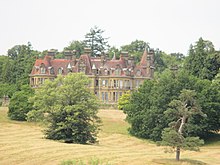Ebrahim Golestan
Ebrahim Golestan | |
|---|---|
| ابراهیم گلستان | |
 Golestan in 1968 | |
| Born | 19 October 1922 Shiraz, Iran |
| Education | University of Tehran (unfinished) |
| Occupation(s) | Writer and director |
| Spouse |
Fakhri Golestan
(m. 1942; died 2012) |
| Partner | Forough Farrokhzad[1] (1960s–1966) |
| Children | Leili and Kaveh |
| Family |
|

Ebrahim Golestan (Taghavi Shirazi) (also spelt Ibrahim Golestan, Persian: ابراهیم گلستان), (born October 19, 1922) is an Iranian filmmaker and literary figure with a career spanning half a century. He has lived in Sussex, United Kingdom, since 1975.
He was closely associated with the eminent Iranian poet Forough Farrokhzad, whom he met in his studio in 1958, until her death. He is said to have inspired her to live more independently.[2] It could also be said that she inspired him in his artistic vision.
Personal life
Golestan was married to his cousin, Fakhri Golestan. He is the father of Iranian photojournalist Kaveh Golestan, and Lili Golestan,[3] translator and owner and artistic director of the Golestan Gallery in Tehran, Iran. His grandson, Mani Haghighi, is also a film director. His other grandson Mehrak, is a rapper.
Golestan was a member of Tudeh Party of Iran, but he broke away in January 1948.[4]
After Farrokhzâd's death, Golestân was protective of her privacy and memory. For example, in response to the publication of a biographical/critical study by Michael Craig Hillmann called A Lonely Woman: Forugh Farrokhzad and Her Poetry (1987), he published a lengthy attack against Hillmann in a Tehran literary magazine,[5] to which Hillmann responded to the attack at length in an article part of which was also published in the same Tehran literary magazine and which is available online at Academia.edu/Michael Hillmann under the title "Az Shâ'eri-ye Nâder Nâderpur to Fârsi'khâni dar Qalb-e Tekzâs, Javâbiyeh'i be Ebrâhim Golestân."
In February 2017, on the occasion of 50 years after Farrokhzad's death, the 94-year-old Golestan broke his silence about his relationship with Forough, speaking to the Guardian's Saeed Kamali Dehghan.[6] “I rue all the years she isn’t here, of course, that’s obvious,” he said. “We were very close, but I can’t measure how much I had feelings for her. How can I? In kilos? In metres?”
Works
Golestan started his film studio Golestan Films in 1957 and produced some documentaries for the National Iranian Oil Company. A Fire and Moj, Marjan and Khara are amongst these films. Golestan also produced the Forough Farrokhzad film The House is Black.[7]
Books
Stories
- Âzar, mâh-e âkher-e pâ’iz (Azar, the last month of autumn), 1948
- Shekâr-e sâyeh (Shadow-hunting), 1955
- Juy-o divâr-o teshneh (The stream, the wall and the thirsty one), 1967
- Madd-o meh (Tide and mist), 1969
- Rooster, 1995
Filmography
Documentaries
- Yek atash (A fire) (1961)
- Moj, marjan, khara (1962)
- The Hills of Marlik (1963)
- The crown jewels of Iran (1965)
Drama
- Adobe and Mirror (1964)
- Asrar ganj dareheye jenni (1974, aka The Ghost Valley's Treasure Mysteries)
References
- ^ http://www.chouk.ir/maghaleh-naghd-gotogoo/1451-2012-02-20-09-32-04.html
- ^ "Farough timeline". Retrieved 8 April 2012.
- ^ Masoud Soheili, Photographer, Portrait & People: Lili Golestan
- ^ Maziar, Behrooz (2000). Rebels With A Cause: The Failure of the Left in Iran. I.B.Tauris. p. 168. ISBN 1860646301.
- ^ "Az Yek Maqâleh va Chand Ostâd."
- ^ Ebrahim Golestan's interview with the Guardian's Saeed Kamali Dehghan
- ^ [1]
- Hamid Dabashi, Masters & Masterpieces of Iranian Cinema, 451 p. (Mage Publishers, Washington, DC, 2007); Chapter III, pp. 71–106: Ebrahim Golestan; Mud Brick and Mirror. ISBN 0-934211-85-X
External links
- Ebrahim Golestan at IMDb
- Articles and short stories by Golestan on Iranian.com
- Video interview with Ebrahim Golestan, by Masoud Behnoud, BBC, 2007
- Parviz Jahed, Brick and Mirror (Khesht va Āyeneh), in Persian, May 15, 2007, [2].
